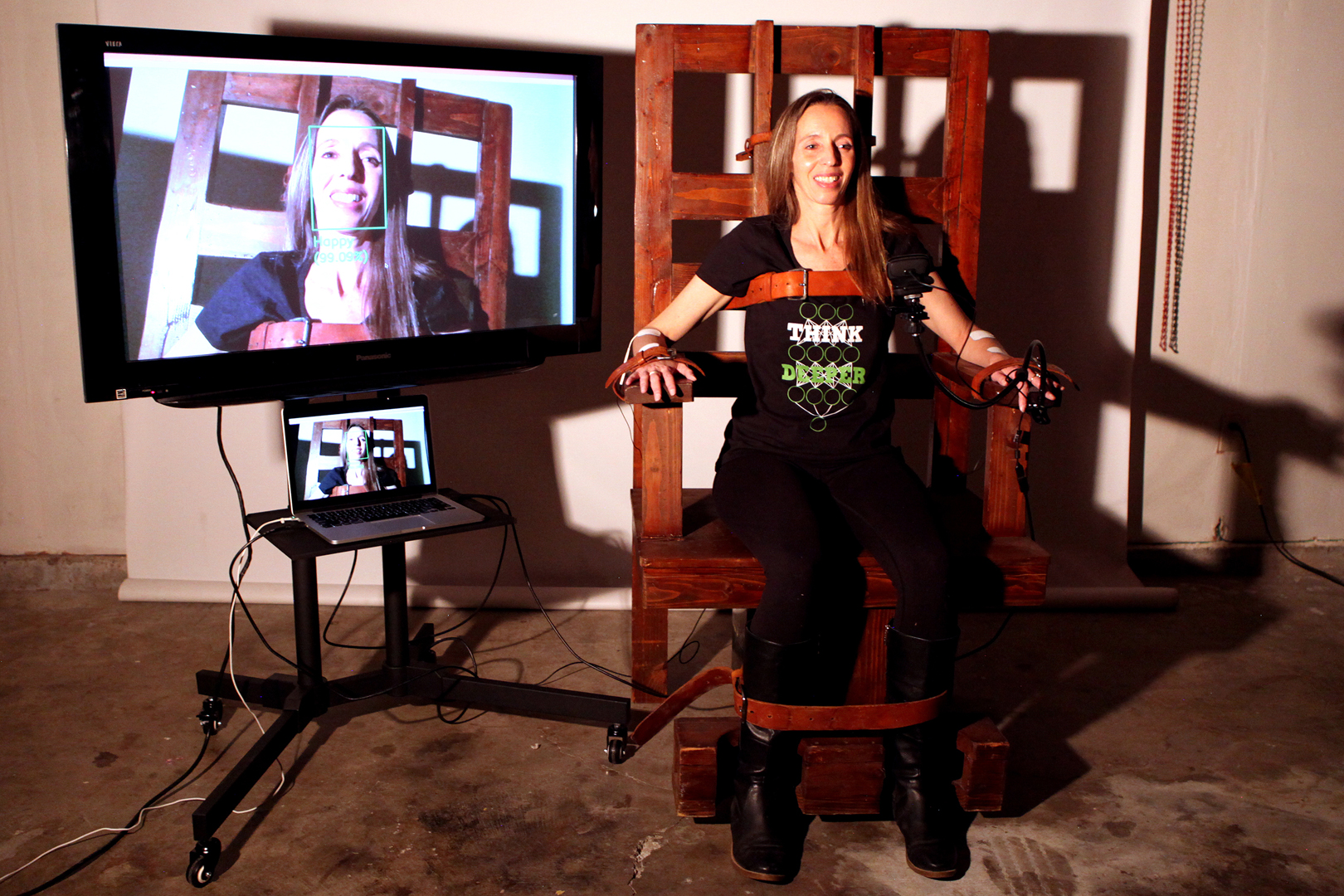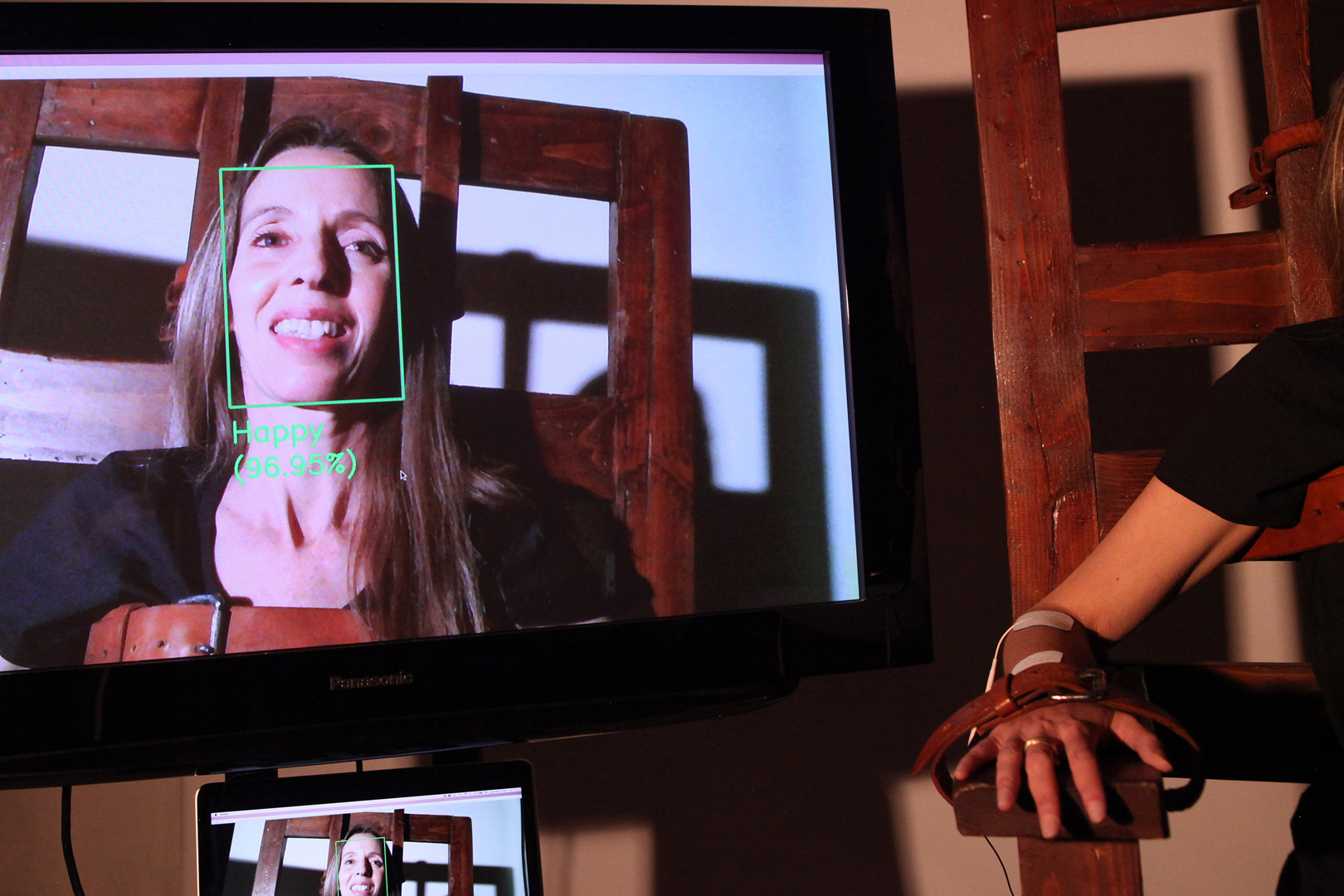Avital Meshi: Don’t Worry, Be Happy
Artist(s):
Title:
- Don't Worry, Be Happy
Exhibition:
Category:
Artist Statement:
Summary
The artist in this performance is strapped to an electric chair. Her face is constantly detected by an emotion recognition AI system. As long as she is detected as ‘Happy’ she is safe. However, if any other emotion is observed, she receives an electric shock to both her arms.
Abstract
Can we look at a person’s face and determine how they feel? AI emotion recognition systems are designed to detect faces and return confidence levels across a set of emotions such as anger, contempt, disgust, fear, happiness, sadness and surprise. Such systems already operate in our environment and might have the influence to seriously impact our lives. In the live performance Don’t Worry, Be Happy, the artist is strapped to an electric chair. Her face is constantly detected by an emotion recognition AI system. As long as she is detected as ‘Happy’ she is safe. However, each time any other emotion is observed, she receives a non-lethal, 2-second long, electric shock to both her arms. During the performance the artist changes her apparent behavior in order to free herself from the ‘punishment’ that the AI system delivers. Yet, under the threat of getting shocked, for how long can she perform this exaggerated facial expression so that the machine continues to ‘read’ her as ‘Happy’?
The apparatus presented in this performance utilizes the electric chair as a reminder of the use of new technologies as instruments of the law. Such tools initially appeared as legitimate solutions and was later own understood as problematic and inhumane. The performance aims to remind the viewers that we are not powerless when we are confronted with AI algorithms that are looking at us. The artist resists the emotion recognition system by faking a smile. This performative engagement points out to a future of a post-algorithmic society in which we change our behavior in order to align it with algorithms in our environment.
What is the relationship between our physical body and our digital one? What kind of new social interactions can be explored while using digital platforms? My practice focuses on new media such as video games, virtual worlds and artificial intelligence and their impact on our social environment and our culture. In my work I invite viewers to explore aspects of their own identity as it is seen through the lens of new technologies. I create large scale, immersive installations and performances where I utilize elements of new media. Viewers acquaint themselves with these technologies and examine new information which is revealed through the interaction. Inspired by ideas of relational and new aesthetics, it is my goal to create spaces where we can intermingle with the machine and better understand the reciprocal agency of both humans and machines to act.
The proposed project relates to the theme of the conference by examining and demonstrating the capabilities and the limitations of AI emotion recognition systems. It specifically focuses on the use of new technologies for punishment and order by the hand of law enforcement. These new tools may initially seem as legitimate and humane and later on are revealed as extremely problematic. The project points out to a future of post-algorithmic society by reminded viewers that we not powerless when we are confronted with such algorithms. We have our own agency to resist and act upon these algorithms. The piece suggests that performative engagement is an active tool which enables us to alter the result of AI recognition algorithms.
Technical Information:
The performance is designed to be presented as a live piece. This can be done online via three separate live video channels. One channel will present a view of the whole apparatus including the electric chair and the artist sitting on it, and the screen showing the artist’s face as it being constantly detected by the AI emotion recognition system. The second channel will present a zoomed view on the screen showing artist’s face and the results of the detected emotions. The third video will be focused on one of the artist’s arms showing the connectedness of the AI system to the body through electric patches and wires. All three videos channels will be in sync with one another so that viewers will be able to see the actual detection of emotions and the response of the system for different kinds of emotions.
Other Information:
Inspiration Behind the Project
Don’t Worry, Be Happy is an interactive AI performance in which I am strapped to an electric chair while my face is constantly being scanned by an AI based emotion recognition system. As long as I am detected as ‘Happy’ I am safe. If, however, any other emotion is detected, my body is electrocuted. I sit on the chair and smile relentlessly in order to avoid the punishment that the system delivers.
The piece is inspired by Franz Kafka’s stories such as The Trial and In The Penal Colony, which describe the problematic relationship between systems and the individuals caught up in them. My motive was to address the problematic nature of AI algorithms when used as a tool of the law. The association between the use of AI and the use of the electric chair was made to point out technologies which are embraced and used before being fully understood. The impact of such technologies may be crucial and sometimes even be a matter of life and death.






